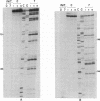Abstract
Bidirectional transcription footprinting has been used to probe the platination of DNA by cisplatin, and to examine the modulation of these interactions by (a) cyclisation of the non-reactive amino group by either ethyl or propyl groups, and (b) the further addition of a pendant intercalator (9-amino acridine) linked by either phenylethyl or phenylpentyl groups. Intrastrand crosslinking was detected for all derivatives at all 5'-GG and 5'-AG sequences on the template strand, but the same sites did not result in transcriptional blockages when on the non-template strand. There was little effect of cyclysation of the amino groups, but the further addition of an intercalator resulted in three responses: a time-dependent increase of the blocked transcript by one and three nucleotides; a reduction of the sequence selectivity of platination; a decrease of apparent interstrand crosslinking for these derivatives with a pendant intercalator tethered to the amino moiety of cisplatin.
Full text
PDF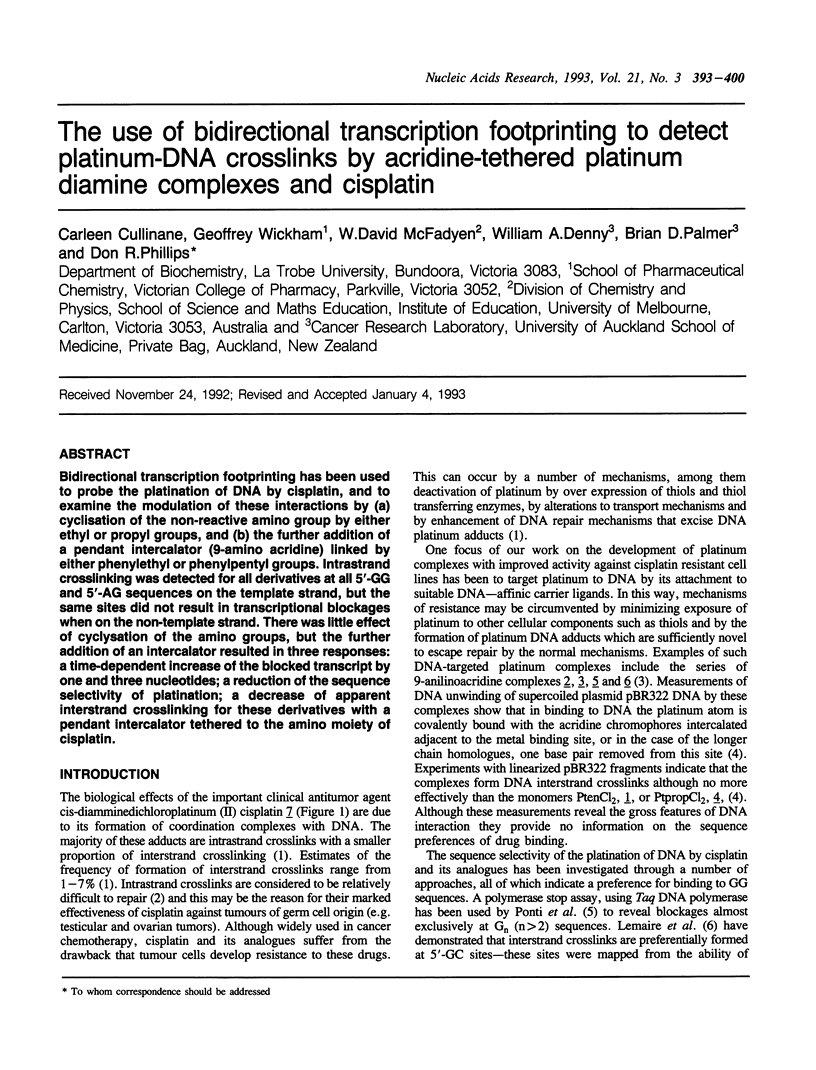

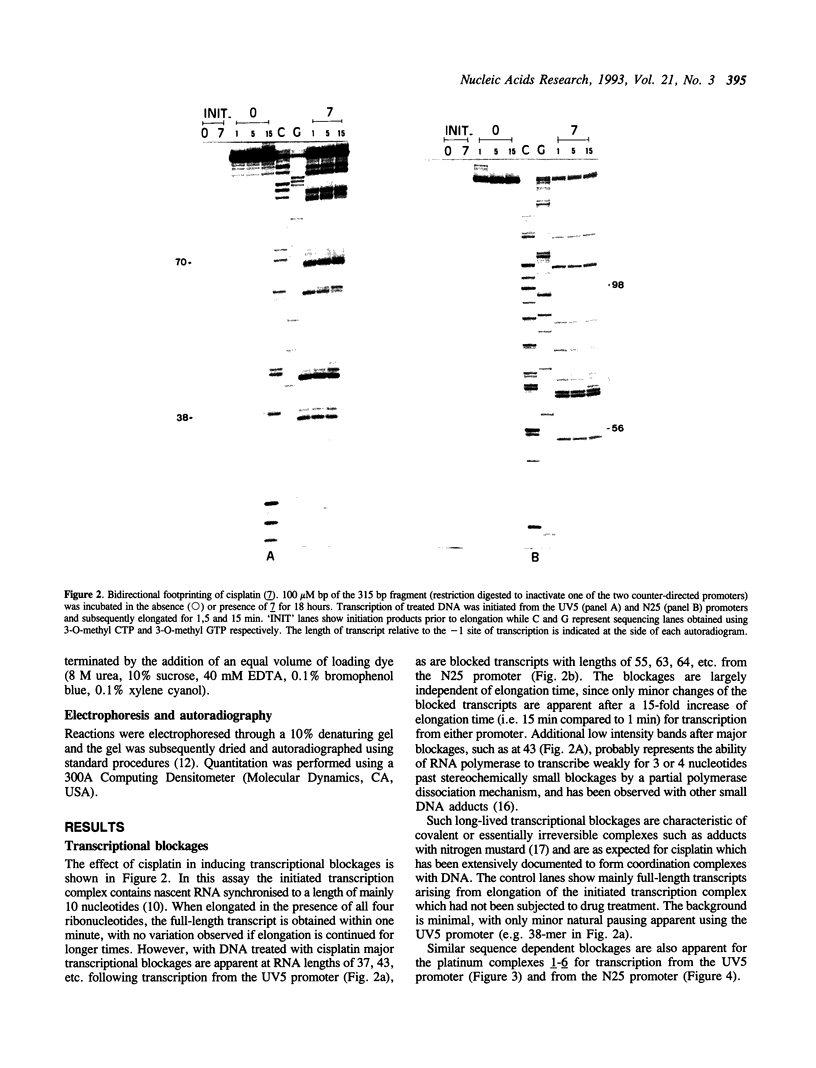
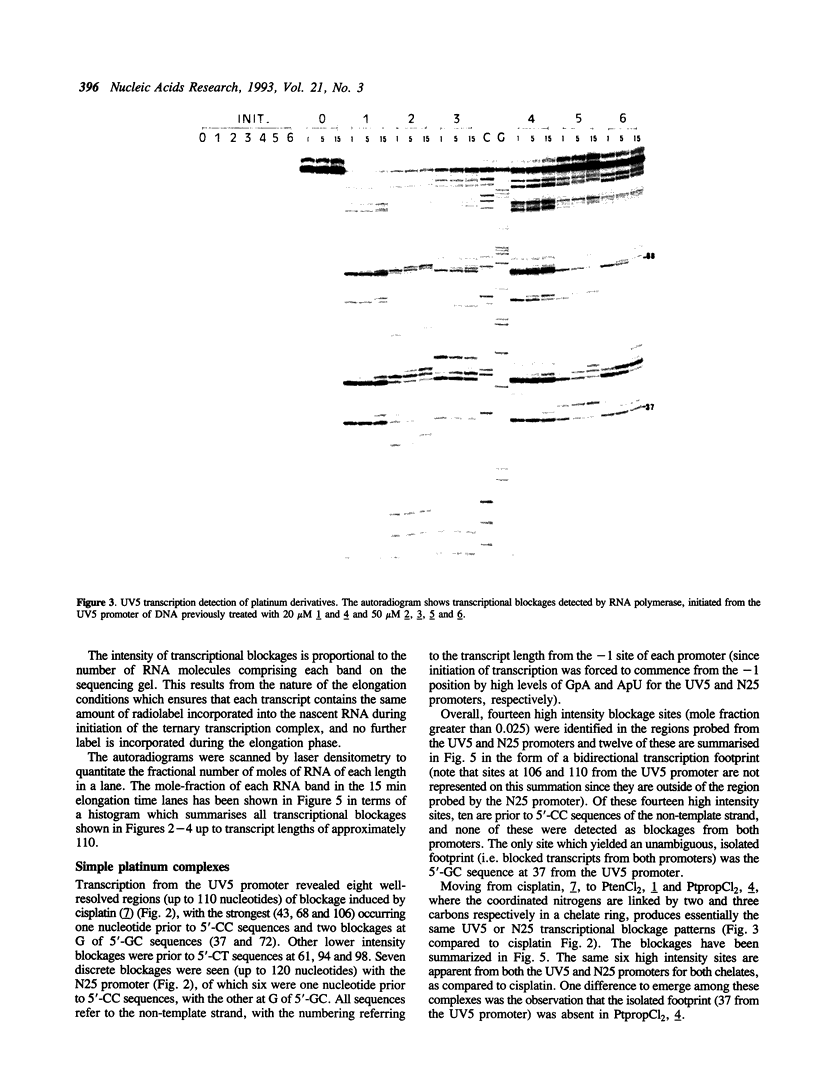
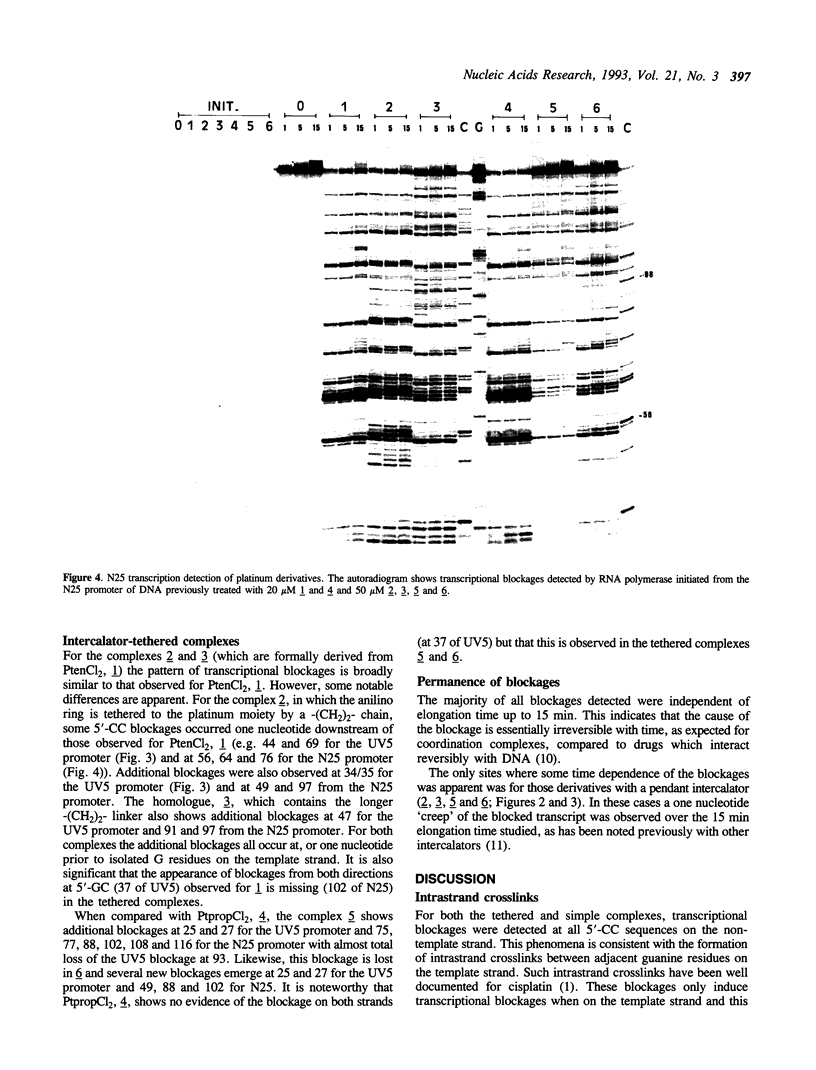
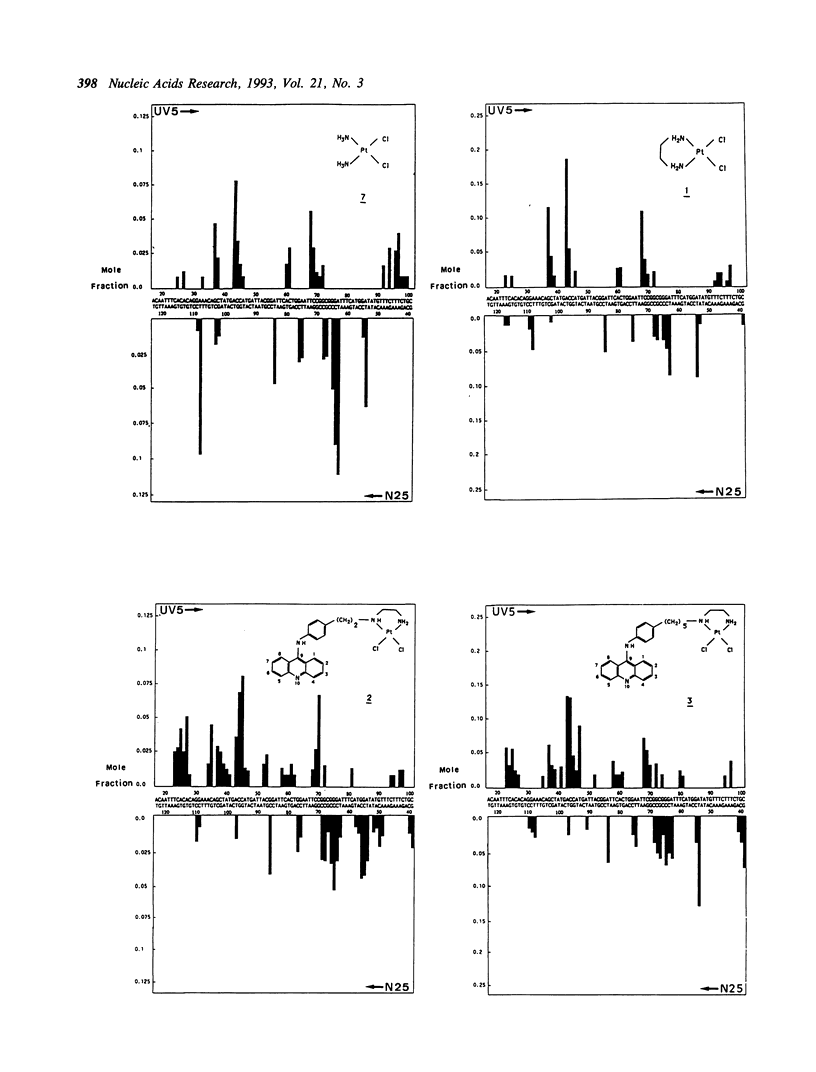
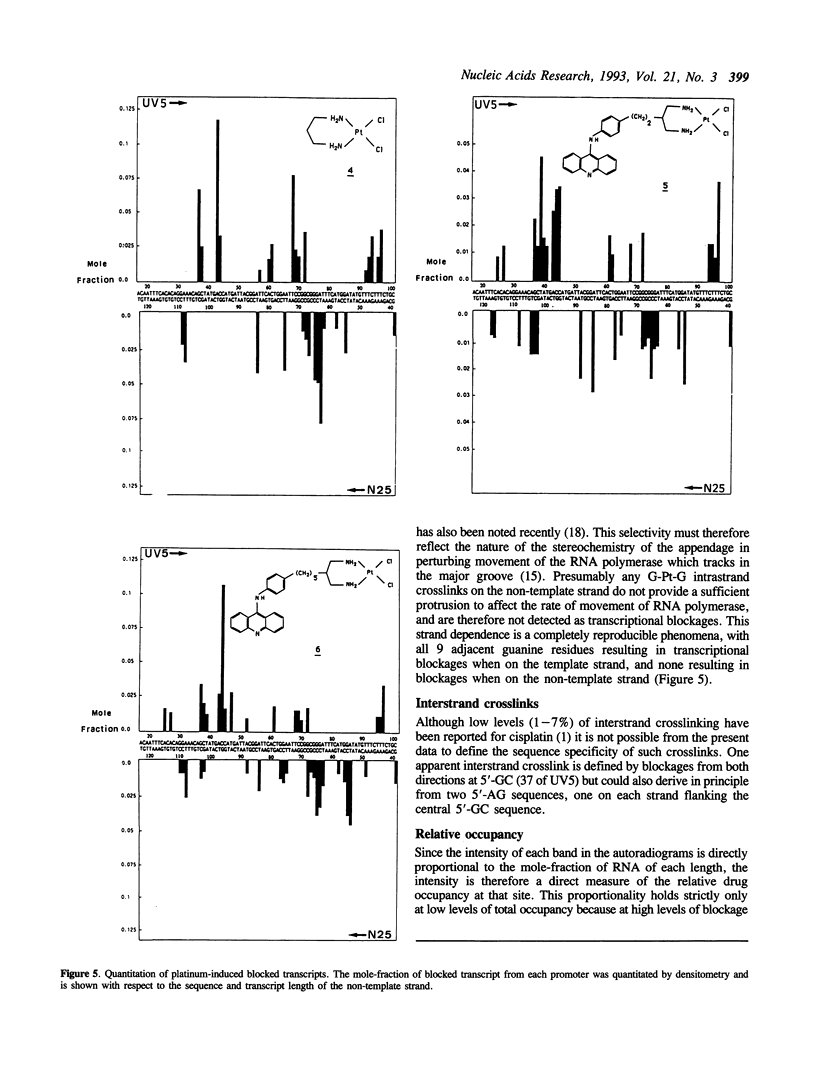
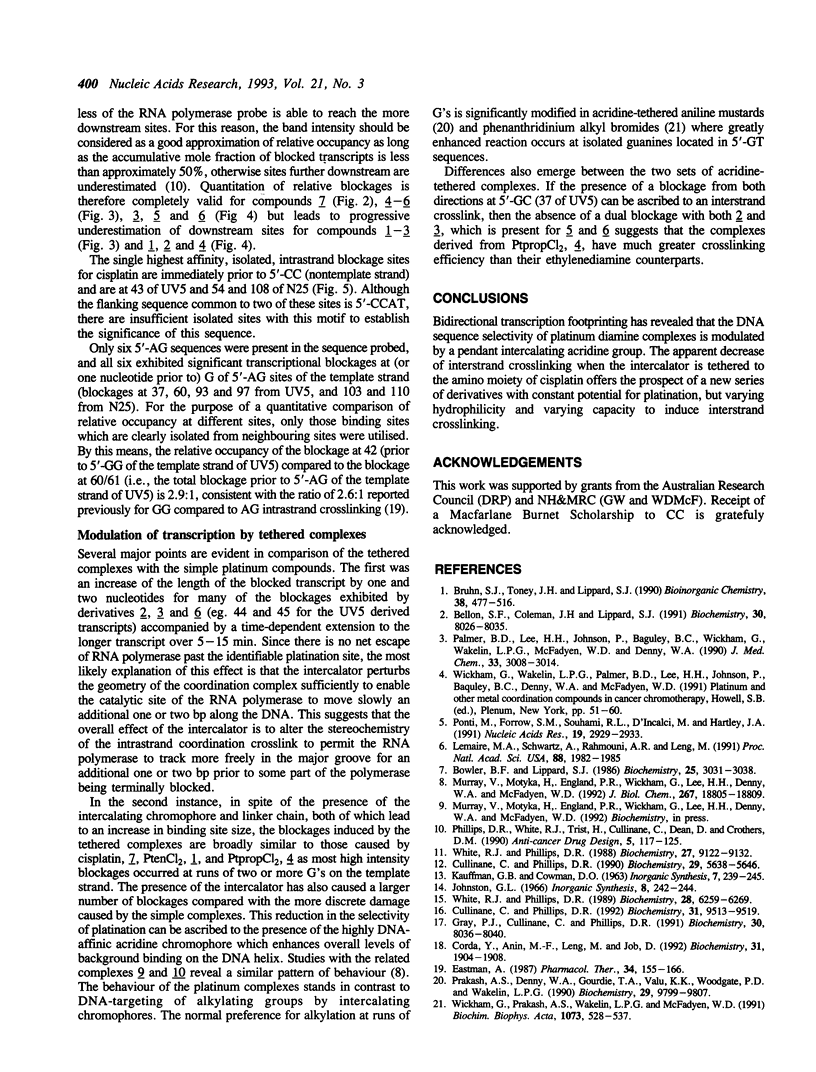
Images in this article
Selected References
These references are in PubMed. This may not be the complete list of references from this article.
- Bellon S. F., Coleman J. H., Lippard S. J. DNA unwinding produced by site-specific intrastrand cross-links of the antitumor drug cis-diamminedichloroplatinum(II). Biochemistry. 1991 Aug 13;30(32):8026–8035. doi: 10.1021/bi00246a021. [DOI] [PubMed] [Google Scholar]
- Bowler B. E., Lippard S. J. Modulation of platinum antitumor drug binding to DNA by linked and free intercalators. Biochemistry. 1986 May 20;25(10):3031–3038. doi: 10.1021/bi00358a044. [DOI] [PubMed] [Google Scholar]
- Corda Y., Anin M. F., Leng M., Job D. RNA polymerases react differently at d(ApG) and d(GpG) adducts in DNA modified by cis-diamminedichloroplatinum(II). Biochemistry. 1992 Feb 25;31(7):1904–1908. doi: 10.1021/bi00122a002. [DOI] [PubMed] [Google Scholar]
- Cullinane C., Phillips D. R. In vitro transcription analysis of DNA adducts induced by cyanomorpholinoadriamycin. Biochemistry. 1992 Oct 13;31(40):9513–9519. doi: 10.1021/bi00155a001. [DOI] [PubMed] [Google Scholar]
- Cullinane C., Phillips D. R. Induction of stable transcriptional blockage sites by adriamycin: GpC specificity of apparent adriamycin-DNA adducts and dependence on iron(III) ions. Biochemistry. 1990 Jun 12;29(23):5638–5646. doi: 10.1021/bi00475a032. [DOI] [PubMed] [Google Scholar]
- Eastman A. The formation, isolation and characterization of DNA adducts produced by anticancer platinum complexes. Pharmacol Ther. 1987;34(2):155–166. doi: 10.1016/0163-7258(87)90009-x. [DOI] [PubMed] [Google Scholar]
- Gray P. J., Cullinane C., Phillips D. R. In vitro transcription analysis of DNA alkylation by nitrogen mustard. Biochemistry. 1991 Aug 13;30(32):8036–8040. doi: 10.1021/bi00246a022. [DOI] [PubMed] [Google Scholar]
- Lemaire M. A., Schwartz A., Rahmouni A. R., Leng M. Interstrand cross-links are preferentially formed at the d(GC) sites in the reaction between cis-diamminedichloroplatinum (II) and DNA. Proc Natl Acad Sci U S A. 1991 Mar 1;88(5):1982–1985. doi: 10.1073/pnas.88.5.1982. [DOI] [PMC free article] [PubMed] [Google Scholar]
- Murray V., Motyka H., England P. R., Wickham G., Lee H. H., Denny W. A., McFadyen W. D. The use of Taq DNA polymerase to determine the sequence specificity of DNA damage caused by cis-diamminedichloroplatinum(II), acridine-tethered platinum(II) diammine complexes or two analogues. J Biol Chem. 1992 Sep 15;267(26):18805–18809. [PubMed] [Google Scholar]
- Palmer B. D., Lee H. H., Johnson P., Baguley B. C., Wickham G., Wakelin L. P., McFadyen W. D., Denny W. A. DNA-directed alkylating agents. 2. Synthesis and biological activity of platinum complexes linked to 9-anilinoacridine. J Med Chem. 1990 Nov;33(11):3008–3014. doi: 10.1021/jm00173a015. [DOI] [PubMed] [Google Scholar]
- Ponti M., Forrow S. M., Souhami R. L., D'Incalci M., Hartley J. A. Measurement of the sequence specificity of covalent DNA modification by antineoplastic agents using Taq DNA polymerase. Nucleic Acids Res. 1991 Jun 11;19(11):2929–2933. doi: 10.1093/nar/19.11.2929. [DOI] [PMC free article] [PubMed] [Google Scholar]
- Prakash A. S., Denny W. A., Gourdie T. A., Valu K. K., Woodgate P. D., Wakelin L. P. DNA-directed alkylating ligands as potential antitumor agents: sequence specificity of alkylation by intercalating aniline mustards. Biochemistry. 1990 Oct 23;29(42):9799–9807. doi: 10.1021/bi00494a007. [DOI] [PubMed] [Google Scholar]
- White R. J., Phillips D. R. Bidirectional transcription footprinting of DNA binding ligands. Biochemistry. 1989 Jul 25;28(15):6259–6269. doi: 10.1021/bi00441a018. [DOI] [PubMed] [Google Scholar]
- White R. J., Phillips D. R. Transcriptional analysis of multisite drug-DNA dissociation kinetics: delayed termination of transcription by actinomycin D. Biochemistry. 1988 Dec 27;27(26):9122–9132. doi: 10.1021/bi00426a009. [DOI] [PubMed] [Google Scholar]
- Wickham G., Prakash A. S., Wakelin L. P., McFadyen W. D. DNA-binding properties and antitumour activity of monofunctional alkylating groups attached to the DNA-intercalating chromophore phenanthridine: n-bromoalkylphenanthridinium bromides. Biochim Biophys Acta. 1991 Apr 9;1073(3):528–537. doi: 10.1016/0304-4165(91)90226-7. [DOI] [PubMed] [Google Scholar]



